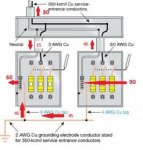This is critical. I'm showing total current on the neutral and GEC. The color I used is representative of current flow as combined/cancelled as the case may be. Note the 90A imbalance of current arriving on panel 2 is opposite phase to the 60A imbalance on panel 1. We are taught that when this happens, the net is 30. And the net is 30....back to the transformer. All is well. What I"m showing is that while the 90/60 gives us 30 back to the transformer, there is 50 on the GEC taps between the neutrals.
The imbalance between phases in panel 1 and panel 2 is reconciled across the GEC taps!!!!! A perfect balance back to the transformer can result in substantial current on the GEC taps between the neutrals. For example, with my previous assumptions, 100 on panel 1 and 100 on panel 2 (split phase to panel 1) will result in a net 0 back to transformer. Hang a current meter on the GEC tap and it will read 67A!!!!


